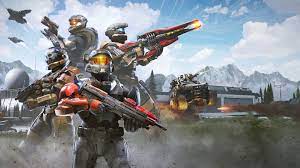‘Halo: Infinite’s’ Multiplayer Doesn’t Weaponize Nostalgia; It’s Actually Good
Video Game Review

“Halo Infinite” is unique and in some way better than other multiplayer games.
December 2, 2021
Games just aren’t what they used to be. This is rhetoric that has increased in frequency. The belief that there’s been a lack of good games has been around for years, but with both the launch of the “Battlefield 2042” beta and “COD: Vanguard” plagued with general criticism of their gameplay and issues of both the technical (lots of bugs) and balancing kind (specifically that planes aren’t powerful enough or that certain guns are too powerful), this criticism seems especially relevant to multiplayer games.
However, the recent release of 343 Industries’ “Halo Infinite” beta is proof that despite the game’s ever-expanding scope, bigger doesn’t make for a better game. Avoiding the pitfalls of nostalgia that returning to its roots could have meant, “Infinite” takes the familiar formula that makes “Halo” unique and makes changes that update and improve it but don’t stray too far from what’s expected.
“Infinite” is ostensibly a beta, but it serves more like a launch for just the multiplayer component of the game in order to build excitement for the campaign. And unlike previous “Halo” games, this one is available on both Xbox and PC at launch. Being a free-to-play game, “Infinite” will feature content seasons in the future similar to the model used by “Apex” or “Fortnite.”
But the biggest change is mechanical. There is a return to equipment instead of abilities. Gone are the days of ground slams and armor locks; now the combat is faster-paced. The game still has equal starts, but to gain the upper hand, you must look throughout the map for said equipment. Equipment such as active camouflage and over shield return but there’s new equipment as well like the grapple hook. The game retains A high time to kill, meaning that even though it is faster-paced, you must still take your time and not be reckless. Unless you’re the second incarnation of gamer Jesus himself, pushing into the wrong corridor and being faced with more than one enemy will probably end badly. And unlike the previous game, “Infinite” is open to both competitive and casual play. The formula has changed enough to be fun for “Halo” veterans and those who’ve never played before. The skill ceiling is high enough to reward those who are skillful, but the skill floor is low enough to not punish the inexperienced, allowing them to actually have fun.
New weapons and vehicles mean that the strategies from previous games won’t work anymore. For example, the MK50 sidekick, which is the new pistol. Or the razorback, a new vehicle with storage space on it. Sprinting and sliding have been kept, but the movement system is just right between mobility and groundedness. The Spartans do have physical augmentations, but each one still weighs at least 500 pounds with their armor on.
Some of the maps deviate from the standard design and are asymmetric. There’s nothing wrong with symmetrical maps, but if you use too many, they all start to blend together and give you the sense that you’re playing on nothing but a glorified rectangle with one team on each side. The asymmetry means you’re not always moving in just one direction, you’re fighting on multiple fronts. Combined with the new verticality provided by the grapple hook, “Halo’s” map design has hit unprecedented heights.
One of my favorite non-mechanical aspects of the game is the music. Continuing with the theme of old and new synthesizing to create something unlike both, the music takes the familiar concepts and fleshes them out into something unto their own. Most are familiar with what “Halo” music sounds like — a choir, some string instruments, and drums. But “Halo Infinite’s” music doesn’t sound derivative. Rather, it’s a natural progression of what made the music special to begin with. It feels like an homage to the original trilogy of games.
My few criticisms of the game aren’t regarding the mechanics but of the way, 343 Industries has rolled the game out. It has a small map selection. The maps are well designed, but there are only so many times you can play the same ones. Combined with the fact that you can’t filter game modes or maps from playlists, you’re often left playing the same map or game mode multiple times in a row.
The battle pass’ progression system is a frustrating slog to get through. Good performance in games does not yield any extra points; the only way to advance is to play matches (which is worth 50 points a game when it takes 1,000 to advance a level) and weekly challenges. The weekly challenges range from easy to almost completely dependent on luck. It’s almost like moving through quicksand; the more challenges you complete the faster you get swamped with increasingly specific and random challenges. Attempting to complete some of the more specific challenges requires you to actively try to complete them and thus neglect the objective of that particular game, which takes away from the fun.
343 Industries has teased that future seasons won’t simply be cosmetics but will add weapons and maps. The problems the game currently has could easily be fixed with those. With the possibility of new maps, weapons, and vehicles, I am hopeful that “Halo Infinite” has a prosperous future ahead of it. After the reputation that the 343 produced games had garnered, I was expecting a nostalgia-ridden game that tries to pander to all those who stopped playing in recent years. But 343 has made a competent game that stands on its own without relying on the goodwill that previous games have earned the series.


